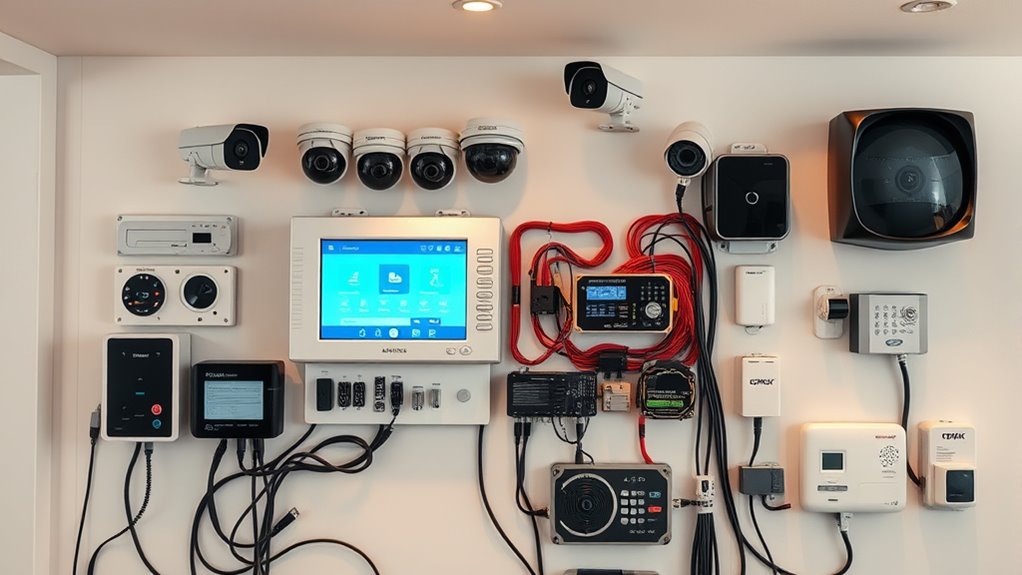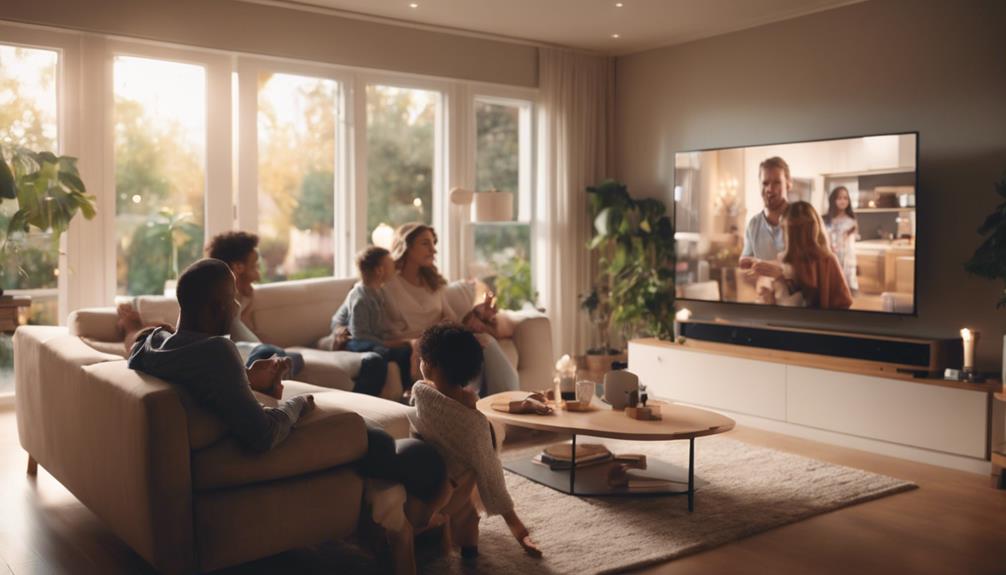Redundancy in home security means having backup systems to keep you safe if one part fails or gets compromised. This includes sensor fusion, power backups, and reliable components working together. By combining multiple sensors and ensuring continuous power, your system stays active during outages or tampering. This layered approach makes your security more trustworthy and resilient. Stay with us to discover how these elements work together to protect your home at all times.
Key Takeaways
- Redundancy in home security ensures continuous protection despite system failures or tampering.
- Combining multiple sensors (sensor fusion) enhances detection accuracy and reduces false alarms.
- Power backup systems like batteries and UPS maintain system operation during outages.
- Integrating sensor fusion with reliable power sources creates a layered, resilient security infrastructure.
- Choosing durable, dependable components minimizes failure risks and strengthens overall system reliability.

Redundancy in home security infrastructures is essential for ensuring your safety even if one system fails. When it comes to protecting your home, relying on a single security measure isn’t enough. That’s where redundancy comes into play, providing backup layers that keep your security intact despite technical issues or power outages. One key aspect is sensor fusion, which combines data from multiple sensors—such as motion detectors, door/window contacts, and cameras—to create a more reliable and accurate security picture. Instead of a single sensor’s false alarm or malfunction causing unnecessary panic, sensor fusion cross-verifies alerts, reducing false positives and ensuring you’re only notified when genuine threats are detected. This multi-sensor approach adds a crucial layer of redundancy, making your system more resilient against failures and tampering.
Alongside sensor fusion, power backup systems are vital. Power outages are unpredictable, but your security shouldn’t be. With a dependable power backup—such as batteries or uninterruptible power supplies (UPS)—your security infrastructure remains operational during blackouts. This ensures that cameras keep recording, alarms stay active, and sensors continue monitoring your home. Without power backup, even the most advanced security system becomes useless once the main power is cut. By integrating backup power solutions, you guarantee continuous protection, even in emergencies. This redundancy ensures that your security measures are never completely compromised, providing peace of mind knowing that your home remains protected regardless of external circumstances.
Implementing redundancy isn’t just about adding more components; it’s about thoughtful integration. Sensor fusion works best when paired with a reliable power backup, which makes your entire system more robust. For example, if a sensor detects movement but loses power during an outage, backup power ensures the sensor’s data still reaches your central security hub. Similarly, alarms triggered by sensor fusion are more trustworthy when powered by a backup, preventing a scenario where a false alarm goes unnoticed due to power loss. This layered approach minimizes vulnerabilities, making it harder for intruders to bypass your security.
Additionally, understanding the importance of reliable components helps in selecting systems that are less prone to failure, further strengthening your security infrastructure. Ultimately, understanding the importance of redundancy in your home security setup means recognizing that no single system is infallible. Combining sensor fusion with a solid power backup creates a resilient infrastructure that keeps you safe under a variety of circumstances. It’s about building a system that adapts, compensates, and stays active when you need it most. In doing so, you’re not just installing security devices—you’re creating a reliable shield that guards your home against failures, ensuring your safety is never compromised.
Frequently Asked Questions
How Does Redundancy Impact Overall Home Security Costs?
Redundancy increases your overall home security costs because you’re investing in backup systems like extra sensors or cameras. However, doing a cost-benefit analysis helps you determine if the added protection justifies the expense. Consider your budget considerations carefully; redundancy can prevent costly security breaches or false alarms later on. While it raises upfront costs, it often pays off by providing peace of mind and reliable coverage, ultimately improving your home’s safety.
Can Redundancy Cause False Alarms or System Malfunctions?
Redundancy can sometimes cause false alarms or system malfunctions if the backup systems aren’t properly configured or synchronized. When multiple sensors or alarm layers trigger simultaneously, it might lead to confusion and false alerts. To avoid this, you should regularly test and calibrate your redundant systems, ensuring they work harmoniously. Proper setup minimizes false alarms and keeps your home security reliable and effective.
What Are the Best Practices for Maintaining Redundant Security Systems?
Maintain your redundant security systems by regularly testing security system integration, guaranteeing backup power sources are fully functional, and updating software promptly. You should check that all components communicate seamlessly, backups activate during outages, and sensors remain calibrated. Consistently review and document your procedures, perform scheduled drills, and keep spare parts handy. These practices help you stay prepared, reduce downtime, and ensure your home security system’s reliability and effectiveness.
How Quickly Can Redundant Systems Be Activated After a Failure?
Redundant systems can be activated within seconds after a failure, thanks to backup protocols and system synchronization. When your primary security system fails, the backup kicks in automatically, guaranteeing continuous protection. Modern setups are designed for quick switching, often within just a few seconds, minimizing vulnerability. By maintaining proper backup protocols and keeping systems synchronized, you facilitate seamless shift and reliable security at all times.
Are There Legal or Privacy Concerns With Multiple Security Redundancies?
You should be aware that multiple security redundancies can raise privacy concerns and legal implications. Having several systems may increase the risk of data breaches or unauthorized access, especially if sensitive footage is stored or transmitted improperly. Guarantee your security setup complies with local laws and privacy regulations, and inform everyone involved about how their data is collected, stored, and used. This way, you protect your home and stay legally compliant.
Conclusion
By implementing redundancy in your home security, you naturally create layers of protection that seem almost destined to overlap. It’s no coincidence that the most secure systems often rely on multiple safeguards working together seamlessly. When you understand how redundancy works, you realize it’s not just about preventing breaches but about crafting an invisible safety net—one that feels like a coincidence, yet is deliberately designed to keep you truly protected.








